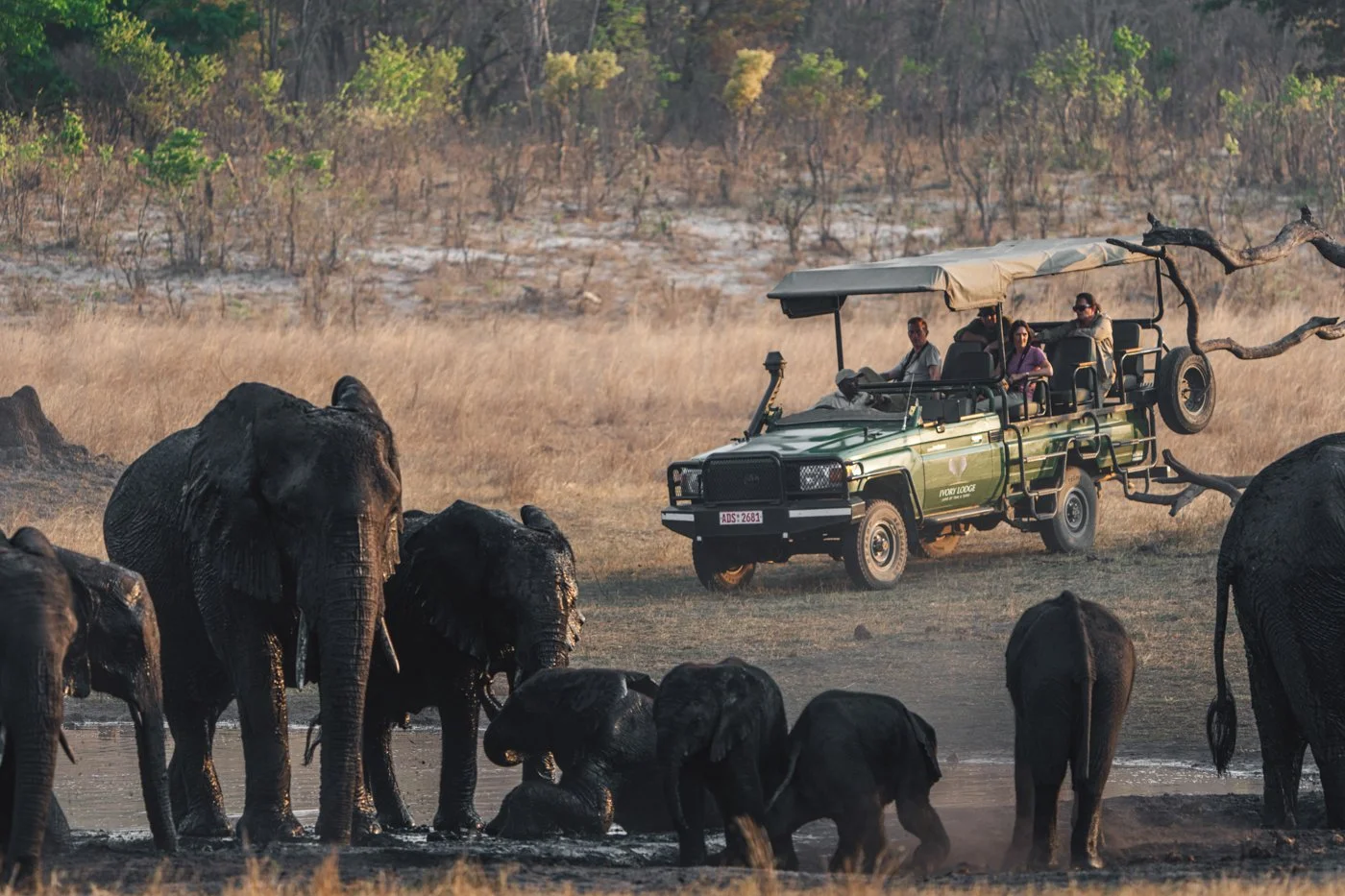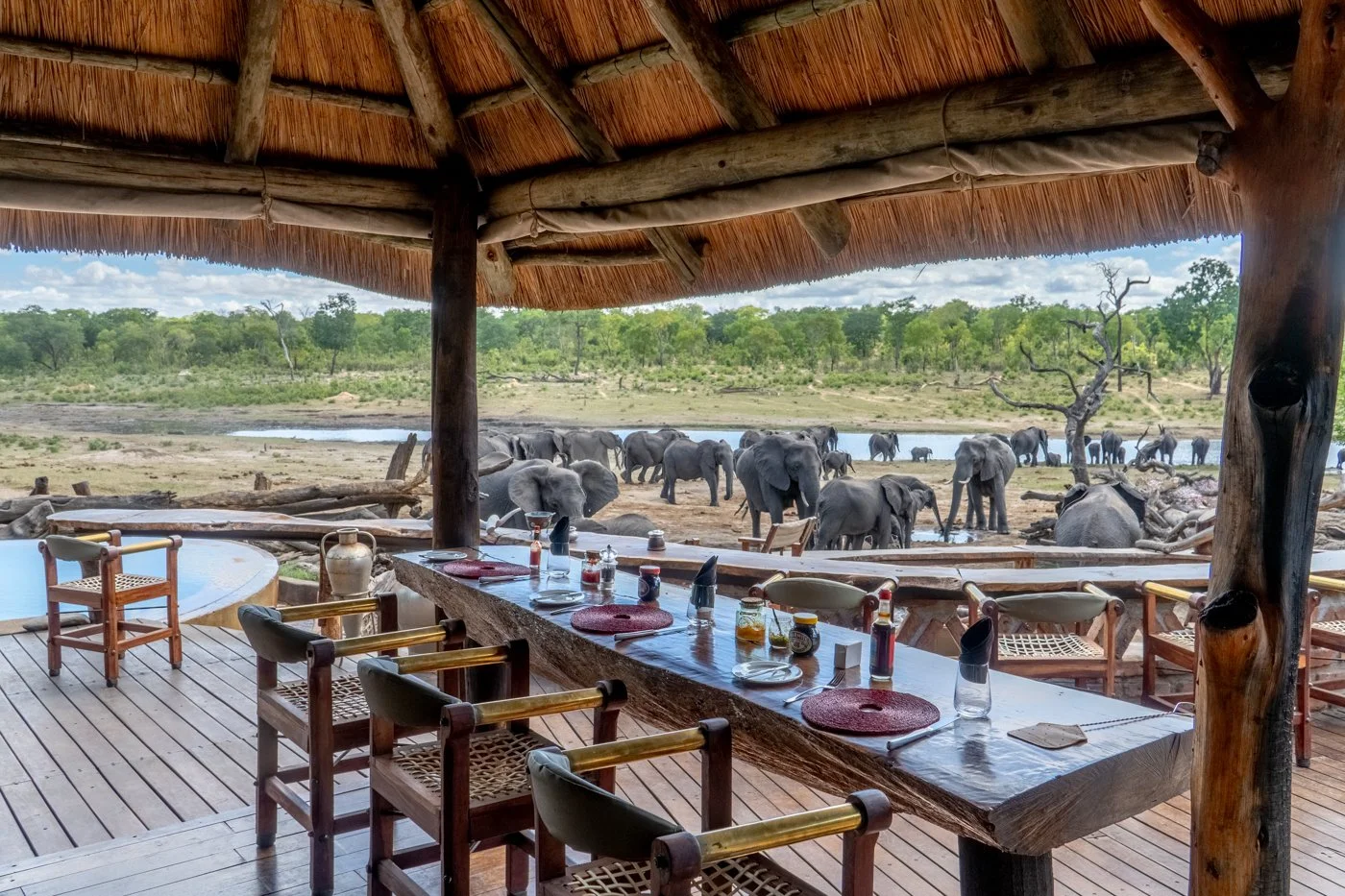Hwange’s Presidential Elephant Herd: A Symbol of Conservation and Legacy of Protection
A Protected Heritage in Hwange
As the sun dips over western Zimbabwe’s savanna, a line of elephants emerges from the thornbush and pads toward a waterhole. These are no ordinary elephants, they belong to Zimbabwe’s Presidential Herd, a unique clan roaming the Hwange region under a special mantle of protection. Decades of near-tame familiarity with safari vehicles mean these giants often approach calmly, sometimes wandering up to lodge waterholes as unwitting ambassadors of wild Africa (1). Their unhurried footfalls in the Kalahari sands carry the weight of history and hope: this herd was singled out by a presidential decree to symbolize a nation’s commitment to wildlife conservation (2). What began as a patriotic gesture has evolved into an enduring story of protection, challenges, and stewardship in one of Africa’s great elephant landscapes.
Origins of the Presidential Herd
The story of the Presidential Elephants traces back to the 1970s, when conservationist Alan Elliot, the original builder of our own Sable Valley, first encountered an especially approachable elephant family near Hwange National Park. At the time, heavy poaching had ravaged local elephant numbers, only about 22 elephants remained in the Hwange Estate area by the late 1970s (1). Elliot noticed that this particular group had become unusually “too friendly” with humans, a double-edged trait that made them delightful to observe but perilously vulnerable (1). Determined to shield them, Elliot began lobbying Zimbabwe’s leadership for a special protected status. His efforts bore fruit in 1990, when President Robert Mugabe issued a historic decree granting these elephants a unique “Presidential” designation and protection (1).
By this order, effectively an anointing of a flagship herd, no elephant in their Hwange range was to be hunted or culled, and the herd was to stand as a living symbol of Zimbabwe’s dedication to wildlife conservation (1,2). This presidential decree was both practical and symbolic. Practically, it aimed to rally Zimbabweans to safeguard these elephants from poachers and trophy hunters (1,2). Symbolically, it declared to the world that Zimbabwe valued its natural heritage: the Presidential Herd would embody the nation’s commitment to “responsible wildlife management,” safe from culling or sport hunting pressures (2,3).
In the words of President Mugabe 21 years later, “It is my great pleasure, 21 years on, to reaffirm this Presidential Decree and Zimbabwe’s commitment to the ongoing protection of this wild clan”(4). By then, the Presidential Elephants had become not only a point of pride but also a litmus test of Zimbabwe’s conservation resolve.
Growth of an Iconic Elephant Clan
Over the decades since 1990, the Presidential Herd grew and thrived. From roughly two dozen survivors that Alan Elliot first named (monikers like Tatty Ear, Inkosikasi, meaning “Queen”, and Skew Tusk became early identifiers (1)), the elephants multiplied under relative safety. By the early 2010s, an estimated 17 extended family groups, about 500 to 600 elephants in total, made up the Presidential Herd (2,5). Their core home remains the Hwange Estate, a 35,000-acre expanse of unfenced land bordering the national park (2).
In reality, this estate is part of a mosaic of protected and communal lands. With only an old railway line marking the park’s edge, the Presidential families wander freely between Hwange National Park and adjacent safari areas (6,3). Any elephant is considered part of the Presidential Herd while it treads within the estate’s boundaries6. Such fluid movement has enriched the gene pool and swelled the herd’s ranks (6).
Crucially, the decades of protection and non-threatening human presence have shaped the herd’s behavior. These elephants are famously relaxed around safari vehicles and researchers, a temperament once considered unusual for wild elephants (6). Matriarchs teach their young that humans are not a danger. Visitors witness extraordinary intimate encounters: gentle giants padding around jeeps or drinking calmly at dusk. This trust is a legacy of their protection and a powerful testament to the impact of long-term conservation.
Political Symbolism and Conservation Commitments
The “Presidential” label was also a political statement. In the wake of the 1980s elephant poaching crises, Zimbabwe’s government sought to assert conservation leadership. Mugabe’s 1990 decree came at a time when Zimbabwe was spearheading sustainable use policies and regulated ivory sales through initiatives like CAMPFIRE (1,2). The special protection of Hwange’s elephants sent a message that Zimbabwe would safeguard its most beloved wildlife.
The herd became a flagship attraction for Hwange, featuring in tourism literature, documentaries, and books. One of the most influential was “All the President’s Elephants,” a film and memoir by Australian conservationist Sharon Pincott, who spent 13 years monitoring the herd (2). Her work under the Presidential Elephant Conservation Project brought global recognition, funding, and a detailed photographic roster of the herd (7).
By 2011, the herd had grown from roughly 200 elephants in 1990 to nearly 600 (5). Mugabe reaffirmed the decree in a public ceremony that year, vowing that Hwange Estate would be protected from mining and hunting (5,2). The herd, in essence, became a national trust, used to reflect Zimbabwe’s conservation integrity.
Challenges Behind the Title
Despite the high-profile decree, practical enforcement lagged. Pincott found that the decree had “nothing implemented on the ground to give weight to [it]”(6). With no dedicated patrols or enforcement, the herd was still vulnerable outside its informal safe zone6.
Public petitions and international pressure eventually led to reaffirmations of the herd’s protected status (2). However, the episode revealed how conservation relies not only on laws but constant political will and active oversight.
The Herd’s Habitat and Behavior
The Presidential Herd centers around Hwange Estate, a mix of teak forest and open vleis adjoining Hwange National Park (1). Unfenced and open, the estate allows elephants to move seasonally between national park lands and the estate, making them part of a broader ecological system connected to the Kavango-Zambezi Transfrontier Conservation Area (6).
The herd's relaxed demeanor around humans is well-known. Inkosikasi, a tuskless cow, was long believed to be one of the founding matriarchs, and Skew Tusk, a cow with a crooked tusk, became an icon of survival6. Visitors frequently report unforgettable moments: elephants drinking from lodge pools, calves playing near vehicles, or bulls calmly resting near campfire decks.
This habituation brings benefits, close observation, tourism income, but also risks. Any lapse in protection could make the trusting elephants easy targets for poachers (6).
Threats to the Presidential Elephants
Despite protection, the herd faces many threats:
Poaching and Ivory Hunting: Hwange was hit by cyanide poisoning in the 2010s that killed over 80 elephants (8). The Presidential Herd’s trusting nature makes them particularly vulnerable.
Land Claims and Habitat Loss: Resettlement and land appropriation, like the Kanondo conflict, remain ongoing concerns (2).
Trophy Hunting Near Boundaries: Legal hunting on adjacent lands puts wandering elephants at risk (2).
Water Scarcity: Droughts and water pump failures have caused mass die-offs in Hwange. In 2012, over 75 elephants died due to dry waterholes (5).
Snaring and Conflict: Elephants caught in snares or killed in retaliation for crop damage represent another steady danger (6).
Conservation Measures and Ongoing Efforts
Key measures protecting the herd include:
Legal Decree: The 1990 Presidential Decree, while not statutory law, remains a strong moral and political safeguard (1).
Research and Monitoring: Pincott’s data and the continued work of the Presidential Elephants Research Trust (PERT) help track herd behavior, migrations, and births (1). PERT also trains local researchers and engages communities (1).
Anti-Poaching: Joint patrols, intelligence-sharing, and community game guards help deter threats (6).
Habitat Protection: The government has blocked destructive projects like coal mining in Hwange Estate, thanks to advocacy based on the herd’s status (5).
Tourism and Community Involvement: Sustainable tourism operators like Amalinda Safari Collection provide employment and tourism revenue to local communities, reinforcing the elephants' value to Zimbabweans (2).
Intimate Encounters with the Herd
For those hoping to encounter Zimbabwe’s most famous elephants, the Amalinda Safari Collection offers some of the best opportunities. With exclusive access to a private concession on the edge of Hwange National Park, guests can observe the Presidential Herd in comfort and close proximity. At Khulu Bush Camp, elephants frequently visit the camp’s iconic pool—often drinking just meters from where guests swim or relax at the firepit. At Sable Valley Lodge, the underground photographic hide offers a rare, eye-level perspective of these giants as they come to drink under the stars or bathe in the heat of the day. And at Ivory Lodge, a hide overlooking a well-frequented waterhole provides another exceptional vantage point. These intimate, respectful encounters are not only a photographer’s dream, they are a chance to witness history in motion, and to support conservation simply by being present.
A Legacy Under Safekeeping
Zimbabwe’s Presidential Elephants remain a testament to what protection can achieve. They embody the power of conservation when backed by public will, community involvement, and continued vigilance. Their fate is now a bellwether for Zimbabwe’s standing in the global conservation community, and a reminder that even symbolic protection must be matched by daily action on the ground.
Bibliography
Presidential Elephants Research Trust. https://presidential-elephants-research-trust.org
Save the Elephants. https://savetheelephants.org
Hideaways Africa. https://hideawaysafrica.com
AllAfrica.com
NewsDay Zimbabwe. https://newsday.co.zw
Zimbabwe Situation. https://zimbabwesituation.com
Reuters. https://reuters.com
Legends and Legacies of Africa. https://legendsandlegaciesofafrica.org
Footnotes
Presidential Elephants Research Trust. “Our Story.” ↩ ↩2 ↩3 ↩4 ↩5 ↩6 ↩7 ↩8 ↩9 ↩10 ↩11 ↩12
Save the Elephants. “A Voice for Elephants.” ↩ ↩2 ↩3 ↩4 ↩5 ↩6 ↩7 ↩8 ↩9 ↩10 ↩11 ↩12 ↩13 ↩14 ↩15
Hideaways Africa. “Hwange is Home to the Presidential Herd.” ↩ ↩2
AllAfrica. “President Mugabe Reaffirms Presidential Elephant Decree.” ↩
NewsDay Zimbabwe. “Mugabe Elephants at Risk,” “Save Presidential Elephants,” “Elephant Die-Offs in Hwange.” ↩ ↩2 ↩3 ↩4 ↩5
Zimbabwe Situation. Excerpts from Sharon Pincott in The Last Elephants. ↩ ↩2 ↩3 ↩4 ↩5 ↩6 ↩7 ↩8 ↩9 ↩10 ↩11
Legends and Legacies of Africa. “Sharon Pincott’s Work with the Presidential Elephants.” ↩
Reuters. “Zimbabwe Poachers Kill 80 Elephants with Cyanide.” ↩




